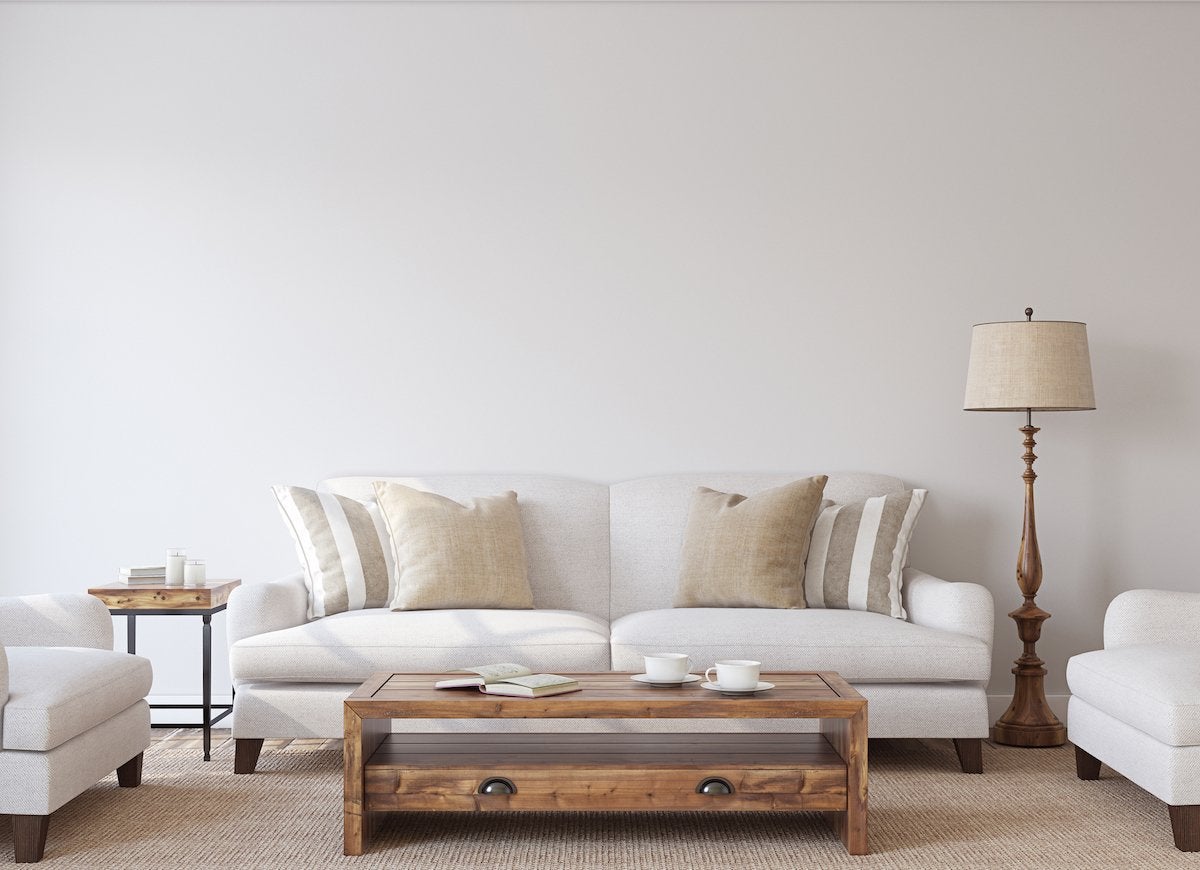We may earn revenue from the products available on this page and participate in affiliate programs. Learn More ›
Not Thinking Ahead

You’re looking for furniture to fill the home you have today, but it would be shortsighted not to consider how your life—and living space—may change in the next several years. If, for example, you’re considering a move within the next five years, think about how your square footage might shrink or expand, how you’ll use the space, and where your furniture would go. An eye toward the future is also wise when you’re shopping for “forever” pieces like sofas and dining tables. Be especially wary of trends. This year’s “it” design may be tomorrow’s 1970s avocado green, so ask yourself if you’re ready to commit to a risky style for the next decade. In short, shop with both the present and future in mind.
Related: 11 Things That Make Any House Feel Old and Outdated
Skipping the Research Phase

Before you shop, do some browsing—in stores and online. Taking the time to window-shop will help you learn your options and average costs before you settle on something you see on the showroom floor. Rely on reviews from reputable sources to determine the quality of the stores you’re visiting as well as the brands and pieces you’d like to buy. This is especially important if you’re planning on ordering online, where you cannot see, touch, or test out the furniture in person. If your favorite chair or sofa has mostly negative reviews, you should probably reconsider your purchase rather than becoming another disappointed customer.
Related: 10 Reliable Products That Have 100+ Years of Good Reviews
Not Being Practical

Take stock of your lifestyle before you choose your furniture. If you like to host dinner parties, you may want to select a dining table with an extra leaf. If you have kids or pets, you’ll probably want upholstery that is easy to clean and will conceal wear and tear. Similarly, be practical when you’re testing out furniture in the store. If that chair feels uncomfortable after a brief perch, it won’t feel any better after you’ve been sitting in it for a long time.
Rushing the Process

Furniture is staged to look great in a showroom, but you need to imagine what it will look like in your home. So, ignore the pushy salesperson or the voice in your head telling you to hurry up. Instead, slow down and be methodical in your shopping. While you’re at the store, test every piece you like—open and close the drawers, sit on the sofa for a few minutes, check the sturdiness of the TV stand. Be sure to take pictures and bring fabric swatches home with you so you can get a sense of how each piece would look in your space. You’re about to spend your hard-earned money, so do so wisely.
Forgetting to Measure

It can’t be said enough: Measure everything! Before you hit the stores, measure your space and the dimensions of the furniture you currently have, whether or not it’s all staying in the room. Although you’re not necessarily planning on buying a piece that’s the same size as what you own now, having a basis of comparison can help you make a decision. Before you settle on a piece, go home and map out potential new furniture arrangements. One good method is to stick painter’s tape on the floor to represent the dimensions of the new piece you’re considering, be it a chair, sofa, or table. Other important spots to measure? The doorways and other passageways through which you’ll be moving your new furniture. The last thing you want on delivery day is to realize there is no way to get that sleeper sofa into your house.
Related: 10 Decorating Mistakes That Make Your House Look Smaller
Buying the Whole Set

When you’re tired of shopping for a bedroom or living room set and you still haven’t found one where every piece is just right for you, it’s tempting to go ahead and buy the whole set anyway and call it done—but doing that could give rise to buyer’s remorse down the line. Your home should reflect your personality and be custom-tailored to fit your way of life, and a matching set, while expedient, may not achieve either of those things. Instead, buy from multiple stores to give your home a layered look, and give yourself permission to collect the perfect pieces over time rather than buying everything all at once.
Related: State Pride: 50 Ways to Show You Love Where You Live
Ignoring Your Budget

Decide on a budget before you shop, then actually stick to it. If possible, pay in cash that you’ve set aside for the purchase so you wan’t be tempted to spend more than you intended. Although many stores will encourage you to open a store credit card to purchase a big-ticket item, don’t feel pressured to sign up. A line of credit with a low interest rate may sound like a deal, but keep in mind that the interest will add up, and your furniture will end up costing you much more than you had planned to spend. Remember, this is a major purchase that you’ll enjoy for years, and you’ll enjoy it much more if you know it didn’t leave you thousands of dollars in debt!
Get Shopping

With these lessons in mind, start shopping for the furniture you need to complete your space. The next time you plop down on your new sofa, you’ll have the peace of mind knowing that you spent your hard-earned money wisely.

Save Energy While Staying Cozy
Today’s energy-efficient space heaters warm individual rooms, so users needn’t heat unoccupied areas of the house. We tested the most popular space heaters on the market to find out which ones performed the best.
